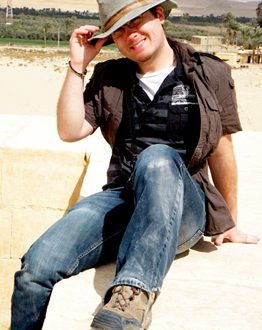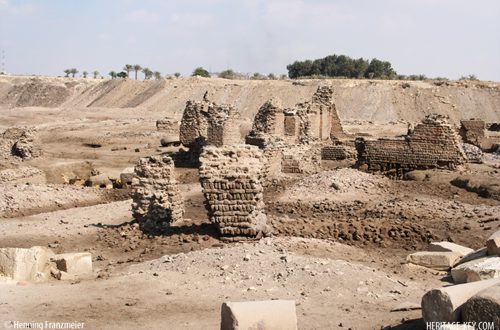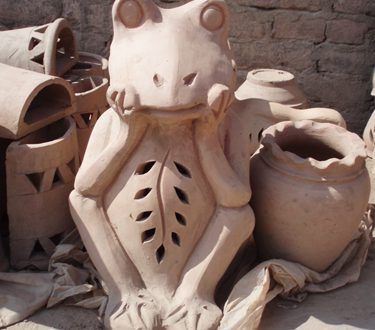 Driving through the desert in search of whales sounds counterproductive, but I had been assured that if I hired a jeep and drove seventy kilometres from Egypts Faiyum Oasis out into the Sahara this is indeed what I would find. If this was a ruse it was a clever one, and UNESCO were in on it.
Driving through the desert in search of whales sounds counterproductive, but I had been assured that if I hired a jeep and drove seventy kilometres from Egypts Faiyum Oasis out into the Sahara this is indeed what I would find. If this was a ruse it was a clever one, and UNESCO were in on it.
The cream coloured 4×4 arrived at nine AM. Perfectly on time a good sign. The driver, Mohammed, was a youngish man, perhaps in his early thirties, sporting a thick goatee beard and wearing a red and white chequered headscarf. He smiled and shook my hand. He had a confident air about him; this was reassuring as effectively, out in the desert, my life would be in his hands. The vehicle was less reassuring. Of unknown origin, it looked as if it had been driven from Russia the long way around the planet. On one side it was painted with the words, Land Croser, and on the other, Land Roser; a leaping leopard was emblazoned upon the front doors on both sides, but the image to the right had faded until only the leopards spots remained to form its feline shape. The vehicle was clearly the closest a machine could get to being un-dead, having been resurrected again and again by Egyptian shamans of engineering. A young boy of thirteen or fourteen sat in the front passenger seat; apparently he was coming along for the ride as Mohammeds apprentice. This was again reassuring; it meant that Mohammed had done this sort of thing before, at least enough times to act as a teacher. The sombre shape of the vehicle was now less threatening and became more a symbol of adventure, something a more perfect machine couldnt embody. My mind began to draw pictures of the rickety old jeep, driven by Mohammed, valiantly fighting through the desert dunes to the isolated valley where I would find the remains of ancient whales jutting out picturesquely among the rocks.
 Despite the reassurances, my initial nervousness of travelling in this part of Egypt was well founded in experience. The first time Id visited the Faiyum my trip had been violently brought to an abrupt standstill by an exploding tyre. I spent the second journey huddled up at the back of my taxi, trying to keep myself warm after the windscreen had been shattered by some unseen high velocity projectile. In order to keep moving the driver had punched a hole in the shattered glass just big enough to see out. Naturally, this odd situation received no attention from the police. I had decided then and there that my travels in the Faiyum were cursed. Heading out into the middle of the desert in an old soviet Land Croser could thus, very reasonably, spell doom. Just as my mind had drawn romantic visions of desert travel and ancient remains, my mind also drew images of a burnt out soviet wreck far from the road, half buried in a dune, the pathetic charred remains of a leopard barely visible on the blackened, baked side of the vehicle, Mohammed wandering in circles dazed and confused in the darkness, while I stand alone wondering how long it would be polite to wait before I could kill and eat Mohammed and his apprentice, cooked over the burning remains of our 4×4, in a desperate bid for survival.
Despite the reassurances, my initial nervousness of travelling in this part of Egypt was well founded in experience. The first time Id visited the Faiyum my trip had been violently brought to an abrupt standstill by an exploding tyre. I spent the second journey huddled up at the back of my taxi, trying to keep myself warm after the windscreen had been shattered by some unseen high velocity projectile. In order to keep moving the driver had punched a hole in the shattered glass just big enough to see out. Naturally, this odd situation received no attention from the police. I had decided then and there that my travels in the Faiyum were cursed. Heading out into the middle of the desert in an old soviet Land Croser could thus, very reasonably, spell doom. Just as my mind had drawn romantic visions of desert travel and ancient remains, my mind also drew images of a burnt out soviet wreck far from the road, half buried in a dune, the pathetic charred remains of a leopard barely visible on the blackened, baked side of the vehicle, Mohammed wandering in circles dazed and confused in the darkness, while I stand alone wondering how long it would be polite to wait before I could kill and eat Mohammed and his apprentice, cooked over the burning remains of our 4×4, in a desperate bid for survival.
The contrast seen by the ancient Egyptians between the fertile Black Land of the Nile Valley and the chaotic desolation of the Red Land the desert is still very noticeable to anyone travelling from the lush agricultural Eden of the fields into the Western Desert. Driving through the Faiyum I was met by scenes of leaning palm trees, all bowing in the same direction to some unseen master, donkeys carrying heavy loads twice their size, farmers standing in the fields carefully tending their crops in the sun, and bored looking cows and gamoosa-water buffalo standing and staring contemplatively at passersby. Behind them all, Lake Qarun was glimmering in the sunlight, while the distant desert hills beyond glowed a yellowish-red, emanating and sweating heat.
The whales were in Wadi El Hitan, The Valley of the Whales, deep within the Wadi Al Rayan Protected Area just south-west of the Faiyum Oasis. In the 1970s three artificial lakes were created here consisting of agricultural drainage water from the Faiyum, although one of these lakes had since dried up. In recent times the area has become a popular weekend holiday destination for Cairenes wanting to escape the bustle and pollution of the city. In 1989 the Wadi Al Rayan was designated a protected area, not surprising given that it is rich in wildlife and geological attractions, including a small oasis, waterfalls, and a large and varied bird population. My aim, however, was just to see the whales.
Although Wadi El Hitan had become Egypts first natural World Heritage Site in 2005 it is still only accessible by a desert track that leads off from the main asphalt road which connects Wadi Al Rayans major attractions; it is also much further out into the desert than any other tourist site within the protected zone. It thus emanated a sense of isolation, adventure, and danger, beyond the typical tourist experience, and so appealed to the moustachioed hat-wearing Nineteenth Century adventurer within me. Finally I could escape the tourist circuit, the herds that cram the Pyramids of Giza and the temples of Luxor. This would be man-versus-desert in the untamed wilderness that exists beyond visitors centres, informative panels, and loud-mouthed guides.
Bumping along the road that leads out of the fields of the Faiyum and into the Sahara I watched as the desert changed before me. Just in the space between the entrance to the Wadi Al Rayan and the turn off to Wadi El Hitan, twenty-five kilometres away, it had morphed from dark and speckled to white and clean, to golden dunes, and then back again to clean and flat. Here tyre tracks led off-road in all directions, criss-crossing one another as they disappeared into the distance; apparently no-one felt compelled to adhere to the occasional no off-roading and stay on track signs that would whizz by. Mohammed ignored them too, alternately riding on the asphalt road and hopping off to bump along the desert surface. He preferred driving on the desert itself he explained, as I lost a few more brain-cells from high-speed impacts with the ceiling, thrown around like a caged bird shaken by a naughty child.
A small sandstorm began, arising unexpectedly; Mohammed brought the Land Croser to a halt. All around small particles moved together in a violent dance ruled by chaos theory and thermodynamics, ramming the vehicle from all sides. My previous cursed trips to the Faiyum flashed before my eyes, and I began to consider who to eat first. Unperturbed, Mohammed and his young apprentice calmly opened their doors, stepped outside and performed some unseen checks on the engine. They returned soon after and the Land Croser roared to life. (Non)-disaster averted, we turned down the desert track to Wadi El Hitan, leaving the asphalt road behind.
 After crossing a large expanse of clean white desert, rippled like ocean waves frozen in time, a simple entranceway slowly emerged from the dusty horizon. Red and divided in two by the desert track, it marked the entrance to the site. We continued along the road for a short time, passing large rocky hills on the right, while, unexpectedly, a large visitors centre grew closer and closer in front of me. A visitors centre? The moustachioed hat-wearing Nineteenth Century adventurer within choked and spluttered on his Earl Grey. A visitors centre! This didnt fit my courageous, lost-in-the-desert-perhaps-having-to-eat-my-own-driver fantasies. Instantly, upon arrival, I exited the Land Croser and surveyed my surroundings; the first striking feature was that there was a multitude of buildings, all constructed to aesthetically fit the landscape – domed mud-huts with irregularly shaped windows, made entirely from local natural materials. They were reminiscent of ancient desert dwellings or Luke Skywalkers house on Tatooine. There was a gift shop and snacks available in the picnicking and sheesha area, camel hire, toilets and a police hut. Information panels described the site, and maps were free, all bearing the acronym UNESCO. Damn you UNESCO, I seethed, such comfort and safety shouldnt exist in the dangerous expanse of the desert, they should have more respect for my preconceived ideas. I was in the middle of nowhere, the toilet should be a hole behind a rocky outcrop, my drinks should be the ones I foolishly forgot to buy before leaving the Faiyum, I should be in danger of being eaten by a desert fox at least once. I had travelled from a natural oasis to a man-made one.
After crossing a large expanse of clean white desert, rippled like ocean waves frozen in time, a simple entranceway slowly emerged from the dusty horizon. Red and divided in two by the desert track, it marked the entrance to the site. We continued along the road for a short time, passing large rocky hills on the right, while, unexpectedly, a large visitors centre grew closer and closer in front of me. A visitors centre? The moustachioed hat-wearing Nineteenth Century adventurer within choked and spluttered on his Earl Grey. A visitors centre! This didnt fit my courageous, lost-in-the-desert-perhaps-having-to-eat-my-own-driver fantasies. Instantly, upon arrival, I exited the Land Croser and surveyed my surroundings; the first striking feature was that there was a multitude of buildings, all constructed to aesthetically fit the landscape – domed mud-huts with irregularly shaped windows, made entirely from local natural materials. They were reminiscent of ancient desert dwellings or Luke Skywalkers house on Tatooine. There was a gift shop and snacks available in the picnicking and sheesha area, camel hire, toilets and a police hut. Information panels described the site, and maps were free, all bearing the acronym UNESCO. Damn you UNESCO, I seethed, such comfort and safety shouldnt exist in the dangerous expanse of the desert, they should have more respect for my preconceived ideas. I was in the middle of nowhere, the toilet should be a hole behind a rocky outcrop, my drinks should be the ones I foolishly forgot to buy before leaving the Faiyum, I should be in danger of being eaten by a desert fox at least once. I had travelled from a natural oasis to a man-made one.
Nevertheless, I took a map, used the modern clean bathroom, and bought a coke from the snack shop in which, unexpectedly, Mohammeds pregnant wife worked. So much for the dangers of the desert, my hazardous expedition into the unknown – this was a daily commute for a pregnant woman. Mohammed and his apprentice went off to sit and drink tea and chat with the other men idly passing their day smoking sheesha in the covered picnic zone. It was time to find those whales.
 The path to the whales was clearly marked out by rows of red rocks. I followed them to the first exhibit which displayed the fossilised lower jaw bone, ribs and vertebrae of an ancient whale known as Basilosaurus Isis, a type of whale that still had functional hind limbs from an earlier phase as a land-based mammal. It was marked by a circle of small red stones, followed by an inner circle of rope held by stumpy posts. The fossils lay on the surface; while being impressive due to their antiquity, they were at the same time unimposing, as if they had been sitting there sunbathing within their little circle and Id disturbed them. Further remains followed: another type of whale called a Dorudon atrox, a short-toothed sawfish, the curious fossilised burrows of wood digesting Teredo, a marine turtle, and the fossilised mangrove roots that once formed a shallow coastline, and in which the various carcases of these animals had once become entangled. Between the fossil displays were small domed huts containing information panels describing every aspect of the areas history, and giving particular details about life here in ancient times. All around, as I walked from exhibit to exhibit, unusual rock formations dotted the landscape; pillars of stone standing in the desert. Over millions of years the weaker stone had been eaten away by the wind, leaving the harder stone standing. The life history of each column was strikingly visible in the stratigraphy, worn by the rock like a striped jersey.
The path to the whales was clearly marked out by rows of red rocks. I followed them to the first exhibit which displayed the fossilised lower jaw bone, ribs and vertebrae of an ancient whale known as Basilosaurus Isis, a type of whale that still had functional hind limbs from an earlier phase as a land-based mammal. It was marked by a circle of small red stones, followed by an inner circle of rope held by stumpy posts. The fossils lay on the surface; while being impressive due to their antiquity, they were at the same time unimposing, as if they had been sitting there sunbathing within their little circle and Id disturbed them. Further remains followed: another type of whale called a Dorudon atrox, a short-toothed sawfish, the curious fossilised burrows of wood digesting Teredo, a marine turtle, and the fossilised mangrove roots that once formed a shallow coastline, and in which the various carcases of these animals had once become entangled. Between the fossil displays were small domed huts containing information panels describing every aspect of the areas history, and giving particular details about life here in ancient times. All around, as I walked from exhibit to exhibit, unusual rock formations dotted the landscape; pillars of stone standing in the desert. Over millions of years the weaker stone had been eaten away by the wind, leaving the harder stone standing. The life history of each column was strikingly visible in the stratigraphy, worn by the rock like a striped jersey.
My mental picture of an isolated area, deep in the desert, where the intrepid adventurer could find whale bones tantalisingly emerging from the sand had been composed both from fact and fiction, as most preconceived ideas tend to be. The firm reality was, nevertheless, just as exciting. There is a strong sense of isolation and peace at the site, even with a visitors centre nearby. At Wadi El Hitan it is possible to stand atop a rocky hill, listening to nothing but the wind whipping past your ears as you stare off at distant dunes and wind-formed shapes. A moment later, in a domed mud-hut, you can learn about the history of the valley, without ever feeling that the modern information boards and constructions are intrusive. The Nineteenth Century traveller within sat back in his chair and happily smoked on his pipe; apparently not all adventures can be tamed by a visitors centre and picnic zone, some adventures can be enhanced by them.











